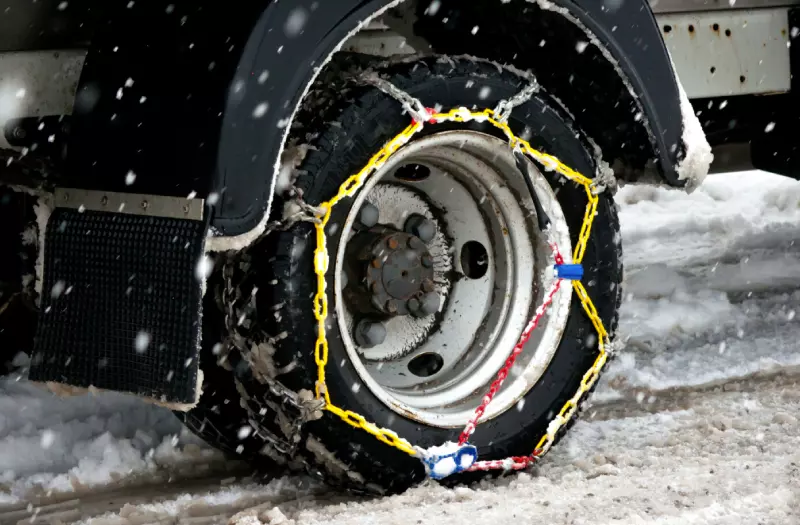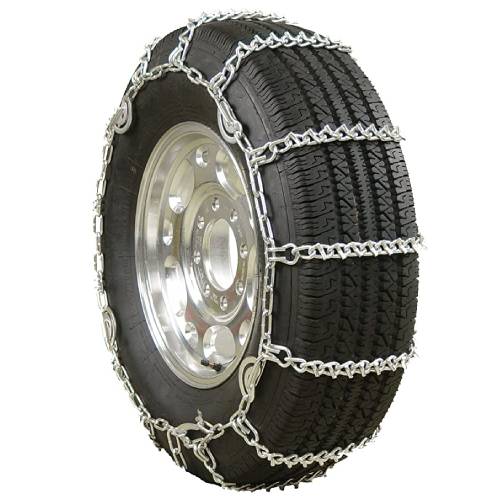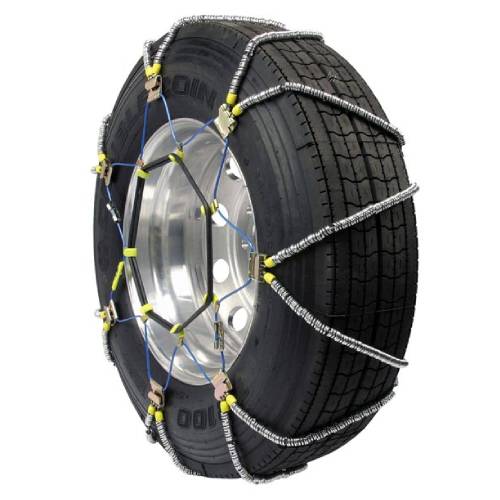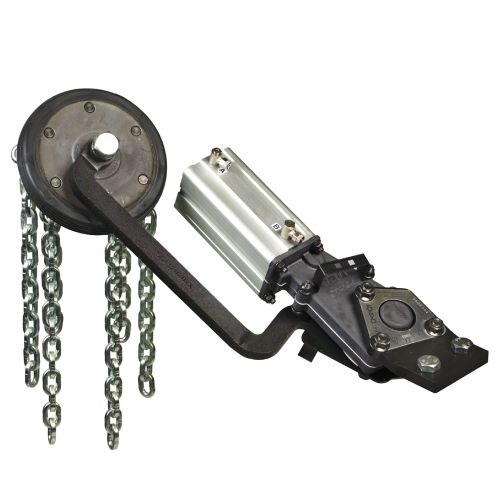During the winter, trucking companies face significantly higher risks of road accidents. Factors leading to accidents during this time include reduced traction, poor visibility, and unpredictable weather, among other reasons.
70% of US roadways are located in snow and ice-prone regions, as per the US Federal Highway Administration. Therefore, nearly 39% of all weather-related accidents occur during the winter while driving on icy, slushy roads or during snowfall.
In such cases, snow chains provide the additional traction required to improve control, braking time, and overall vehicle safety when hauling cargo. Snow chains (or tire chains) are traction accessories installed on a vehicle’s rims and tires to dig into snow and frozen surfaces to improve road grip and prevent skidding when driving on icy roads.
In this article, we’ll explain in detail how these traction devices work and elaborate on the different chain types. We’ll also talk about the cost and the key benefits they offer truckers.
What Are Snow Chains in Trucking?
As the name suggests, snow chains are meshes of metal chains fitted around a truck’s tires with the primary function of enhancing road grip on icy surfaces. Aside from metal, they can also be made of other materials, such as plastic and nylon.

They are typically sold in pairs or sets, depending on the tire size (tread width and diameter). Most countries with wet and icy road conditions have introduced different deicing solutions, such as sprinkling large quantities of rock or table salt on roads.
However, when hauling thousands of pounds of cargo at 50+ mph, deicing may not be enough to provide trucks the traction they need to control their momentum and improve handling.
Modern freight vehicles can haul up to 80,000 pounds of cargo at speeds ranging between 55 and 80 mph, depending on their Gross Vehicle Weight Rating (GVWR) and state speed limits.
As a result, their sheer force and momentum make them difficult to control and stop, even in good weather and road conditions. Therefore, snow chain manufacturers have invested a substantial amount of time and effort into developing innovative technologies and designs to provide the best possible traction.
As such, drivers have to do a lot of research and seek professional guidance to pick the right type and size. The last thing you want to do is purchase an unsuitable one and increase the risk of them dislodging during your trip.
Dislodged snow chains can cause misbalances, that can eventually lead to accidents during wide turns, braking, jackknifing, and rear-end collisions. Moreover, truck tires can cost anywhere between $250 and $1,200, so you need to ensure you don’t damage them by installing the wrong chains.
Make sure to check out our guide on how to put snow chains on semi-trucks for more information.
How Do Snow Chains for Trucks Work?
Snow chains wrap around tires and provide additional traction to prevent slipping. In other words, they enhance your tire’s grip on snow, water, and ice-covered surfaces and enable drivers to brake more effectively.
Additionally, they also reduce wheel spin and increase the downward force delivered to the surface to prevent getting stuck as drivers attempt to drive through snow patches.
While the reduced friction on the tire treads can increase their life span, driving on bare asphalt with chains on would have the opposite effect. When it comes to snow chain installation, you should attach and fix them on your truck’s drive wheels.
Most freight trucks in the market are rear-wheel drive. Hence, the chains usually go on the back tires. Most heavy trucks also require multi-arm adjustors to fit, tighten and maintain the required amount of tension on the tires for improved traction on icy roads.
Snow Chain Regulations
Besides equipping their semis with snow chains, truckers also need to learn how to install them and operate their vehicles according to the best practices, such as not exceeding speeds of 30 mph when chained. Doing so will help them improve road safety and ensure compliance with regulatory authorities.
Most US states, including Wisconsin, Tennessee, Colorado, and Montana, require truckers to install and use tire chains when ice, snow, and other dangerous roads are present. However, tire chain laws vary from state to state.
For instance, Colorado requires truckers to have snow chains between September and May when hauling cargo through I-70. If you’re caught without chains, you can be fined $50 with a $16 surcharge.
Additionally, if you don’t have chains installed when the law is in effect, you can face fines of $500 and a $78 surcharge. The maximum one-time fine and surcharge of $1,000 and $156 are for trucks without snow chains blocking the roadways following an accident.
In contrast, California doesn’t require freight vehicles to have snow chains on except on roads with R1 and R2 signs. The R1 sign indicates that chains are required on all trucks above 6,000 lbs gross weight.
Similarly, the R2 sign indicates that all vehicles, with the exception of all-wheel or four-wheel drive vehicles equipped with snow-tread tires, must have snow chains on. However, these vehicles must still carry snow chains or traction devices when driving on California roads.
Types of Snows Chains For Trucks
As mentioned earlier, snow chains come in different configurations, materials, and types. These truck snow chains also feature different designs, each having its own benefits.

Conventional Chains

Cable Chains

Automatic Chains
The three most common truck chains are conventional chains, cable chains, and automatic chains. Let’s take a closer look at each type.
Conventional Chains
Conventional chains are the most popular types of snow chains commonly used for box trucks, semi-trucks, and larger freight vehicles. These traditional options are essentially a set of steel or other alloy chains weaved to fit tires according to their tread width and diameter.
Conventional snow chains are a well-tried design suitable for virtually all ice and snow conditions. They’re also incredibly durable, versatile, and available in most parts of the United States. Furthermore, you can find several variations in terms of mesh configuration and patterns, each offering unique benefits:
- Straight Configuration – Snow chains with a straight configuration are the most common types in the market and often the go-to choice for new truckers. In this configuration, the chain is fit across the entire width of the tire.
- Diamond Configuration – Diamond tire chains are the most popular alternative to straight chains. They feature multiple strings of metal chain links configured in a diamond pattern that increases the contact surface with the ground.
- Double Diamond Configuration – Double-diamond snow chains are variants of diamond chains with more complex weaving. Hence, they’re more suitable for driving in frequent, heavy snow.
- V-Bar Type – V-Bar tire chains have v-shaped metal pieces integrated into the chain links for improved traction on icy roads. They’re highly recommended for hauling cargo in off-road conditions or elevated slippery roads.
- Studded Type – As the name suggests, studded snow chains have studs integrated into the chain links. They’re excellent for icy conditions off-road that require additional digging and grinding to keep moving. The studs penetrate deeper into the snow compared to other variants and maximize friction.
- Dual Tire Fit – Dual-tire snow chains are designed for trucks with dual wheels. They’re available in different patterns and configurations, such as ladder, V-bar, and studded.
Cable Chains
Cable chains are the second-most popular types of snow chains you can find in the market for trucks. They feature lateral metal cables that link to small chains and provide moderate levels of traction.
They’re inexpensive and the go-to option for truckers with a modest budget or those operating on routes with light snowfall and little or no ice accumulation. Moreover, they are easier to fit onto your tires but are not as durable as conventional chains and have fewer variations:
- Straight Configuration – Straight cable chains are similar to straight conventional chains. They feature a ladder-like pattern with smaller cross chains perpendicular to the road.
- Diagonal Configuration – Commonly referred to as Z, V, or lighting cable chains, diagonal cable chains feature a zigzag pattern that allows drivers to enjoy a smoother, less bumpy drive.
- Dual Tire Fit – Dual-tire fit cable chains are inexpensive alternatives to conventional dual-tire chains with multiple locking clips that connect to the same axle.
Automatic Chains
Automatic snow chains are a step up in technological innovation in the trucking industry. They allow operators to install a pneumatic mechanical system under their chassis and mount snow chains permanently near their drive wheels.
With this solution, they can activate and deactivate snow chain functions with the flip of a switch and get extra traction on demand without manual installation every time. The only downside of automatic chains is that they’re not suitable for use in areas that experience heavy snowfall.
They’re also ineffective when driving in reverse. Many truckers have reported their tension system getting stuck or frozen in extremely cold conditions.
How Much Do Truck Chains Cost?
Snow chains that are designed for straight struck and semis are generally inexpensive and can cost anywhere between $100 to $350, depending on the type, configurations, and patterns, build material quality, and brand. Here’s a quick guide:
- Conventional Truck Chains: $140 – $350
- Cable Truck Chains: $100 – $200
- Automatic Truck Chains: $2,000 – $3,000
Conventional truck snow chains typically range between $140 – $350, whereby cable chains are the alternative option for lower budgets with the price range ranging between $100 – $200.
However, it is important to note that the durability and effectiveness of cable chains are also inferior to conventional snow chains and would only be more cost-effective in light snowfall conditions.
Finally, the automatic chains stand at the highest price range of approximately $2,000 – $3,000 or more including installation. While the price range is a huge step up, this technology helps truckers save time and elbow grease from installing and removing tire chains.
In addition to snow chains, you may need multi-arm adjusters, which typically cost around $20 – $50. Most types of chains are available in stores that include:
- Walmart
- AutoZone
- Amazon
- eBay
- Eckler’s
- TireChain
- TireChainsOnline
- Tire Chains ‘R’ Us
Automatic chains are available by directly enquiring with manufacturers as they require installation.
Benefits of Using Snow Chains
Below are the key benefits of using snow chains when hauling cargo in inclement weather and on icy, wet, and snowy roads.
- Road Safety – Snow chains reduce the risk of truck accidents significantly in different ways. For starters, they indirectly prompt drivers to reduce their speeds to 30 mph so they can improve braking time further. The enhanced traction provided by the snow chains enables drivers to improve road grip and ensure they remain in control of their vehicles at all times.
- Legal Compliance – Since almost every US state requires truckers to equip their freight vehicles with snow chains and/or have them in specific conditions or at different periods of the year, opting for one can ensure compliance and prevent unnecessary fines that can add to your operating costs.
- Business Continuity – Although driving on icy roads is highly discouraged, carriers can equip their freight vehicles with snow tires and train their drivers to drive in icy conditions to ensure business continuity. This benefit is especially applicable for trucking companies involved in the transportation of essential goods or time-sensitive orders during the winter season.
- Cost Effectiveness – Snow chains are a cost-effective alternative to genuine snow tires that can easily cost thousands of dollars each. Even then, the best snow tires in the market would be subject to safety risks in icy conditions and would wear out from normal use. Furthermore, planning to switch tires for the winter hauling season would be significantly more challenging than installing and removing chains.

Get Free Course Access
If you enjoyed the article, don’t miss out on our free supply chain courses that help you stay ahead in your industry.

Andrew Lin
Co-Founder & Writer
at freightcourse
About the Author
Andrew is a multi-business owner with over 12 years of experience in the fields of logistics, trucking, manufacturing, operations, training, and education.
Being the co-founder of freightcourse has given him the ability to pursue his desire to educate others on manufacturing and supply chain topics.
Follow us